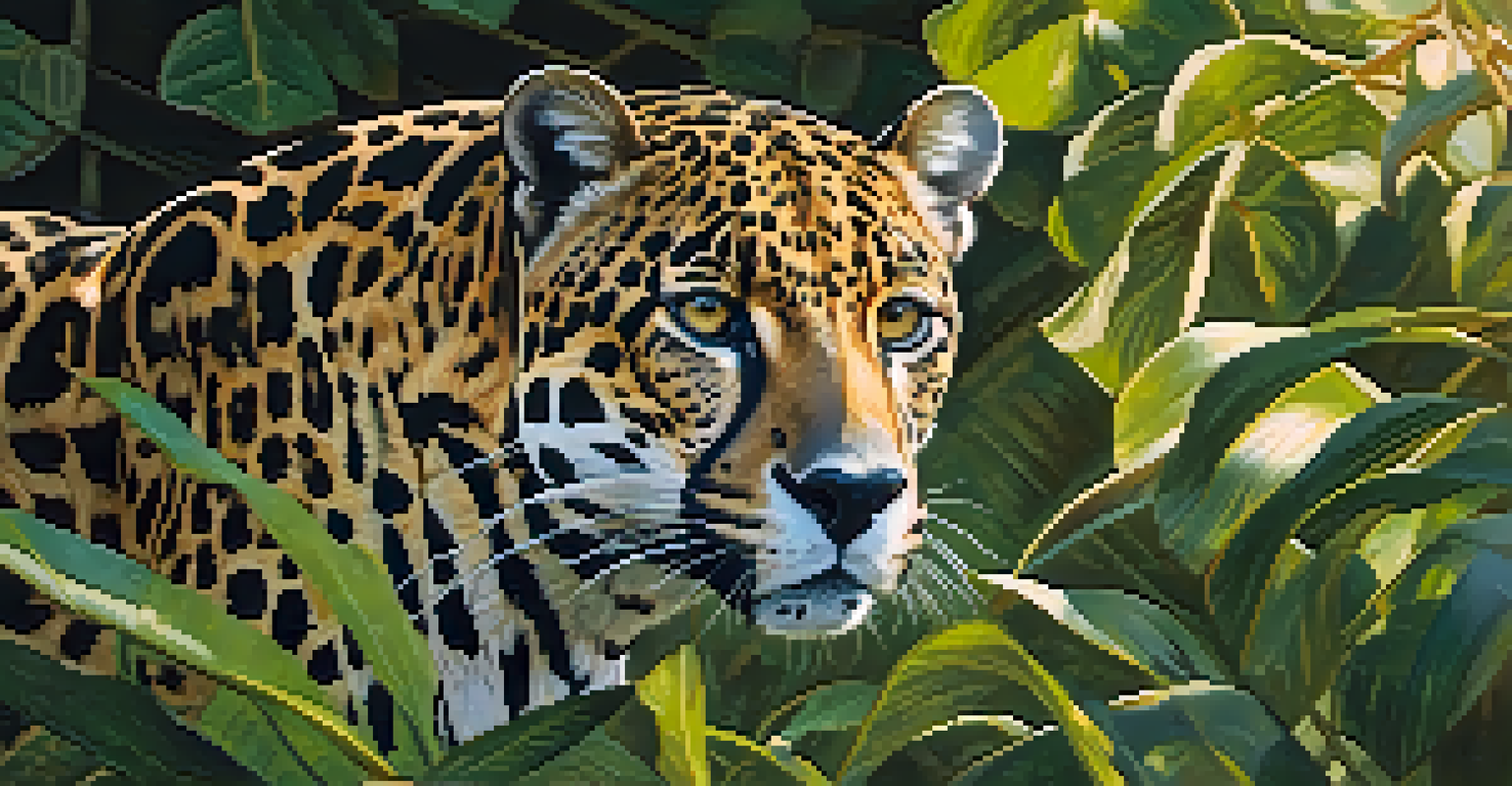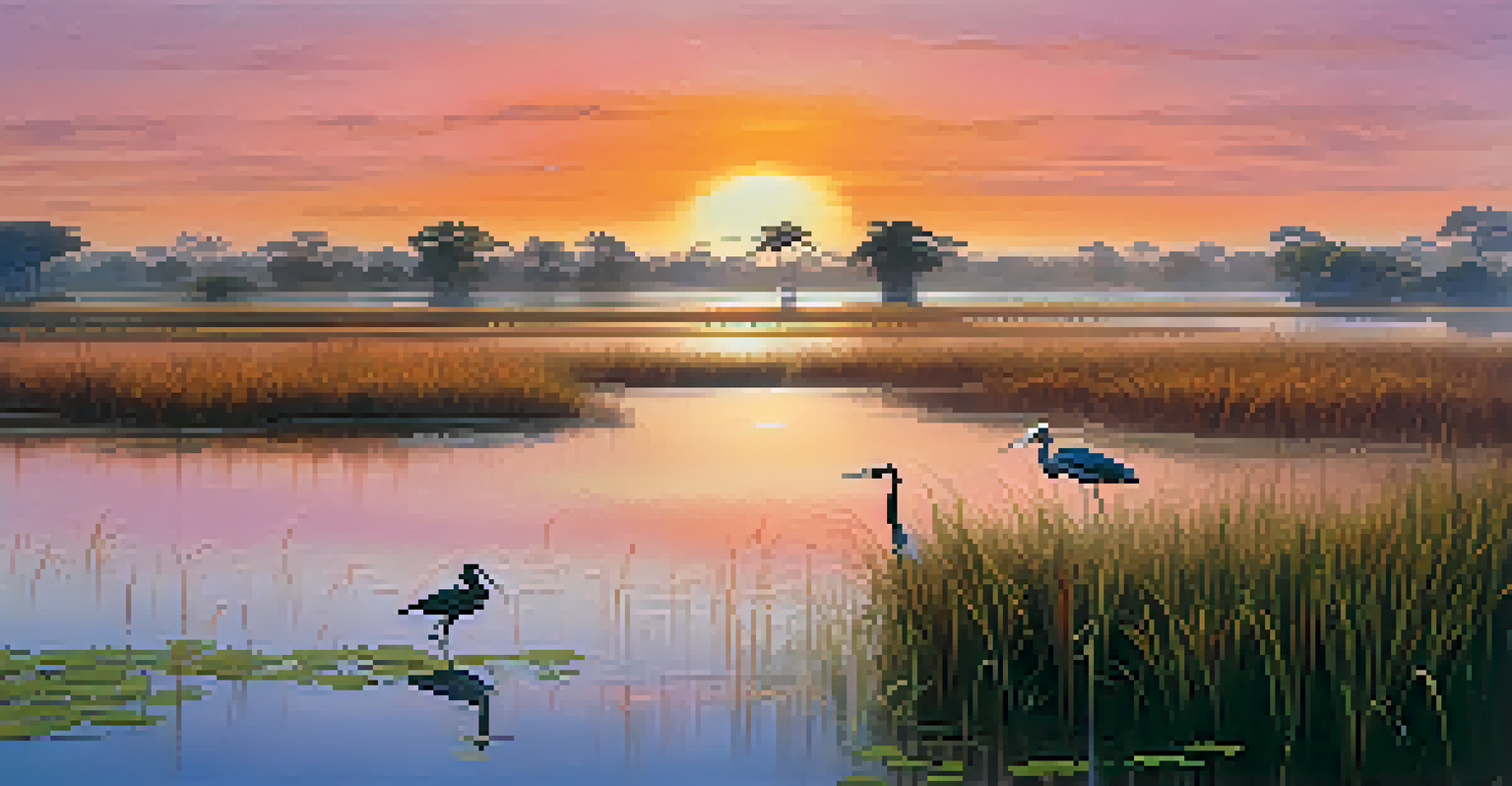The Enchanting Wildlife of the Pantanal Wetlands in Brazil

An Overview of the Pantanal Wetlands
The Pantanal Wetlands, located in Brazil, are one of the world's largest tropical wetland areas. Spanning over 150,000 square kilometers, this vast ecosystem is recognized for its rich biodiversity and unique landscapes. Unlike other wetlands, the Pantanal experiences seasonal flooding, creating a dynamic habitat that supports countless species.
In nature, nothing exists alone.
During the rainy season, the area transforms into a lush paradise, attracting migratory birds and aquatic life. As the waters recede, the landscape evolves, revealing grasslands and forests, each home to different wildlife. This cyclical change not only enriches the environment but also makes the Pantanal a prime location for wildlife enthusiasts and researchers alike.
The Pantanal is a UNESCO World Heritage site, showcasing its ecological significance and beauty. With its mix of rivers, lakes, and savannas, it serves as a crucial resource for both wildlife and local communities. Understanding this unique wetland is essential for conservation efforts and appreciating its role in our planet's health.
Diverse Fauna of the Pantanal
The Pantanal is a treasure trove of wildlife, home to over 1,000 species of animals. From majestic jaguars prowling the underbrush to capybaras lounging by the water, the variety is astounding. Each species plays a critical role in this intricate ecosystem, creating a web of interactions that sustain life in the wetlands.

Birdwatchers will be particularly delighted, as the Pantanal hosts around 650 species of birds, including the vibrant hyacinth macaw and the striking jabiru stork. This rich avian population makes the wetland a paradise for birdwatching and photography. The sights and sounds of these birds add to the enchanting atmosphere of the region.
Biodiversity in Pantanal Wetlands
The Pantanal is home to over 1,000 species of animals, making it a crucial ecosystem rich in wildlife diversity.
Moreover, the Pantanal is also home to numerous reptiles, including caimans and anacondas, which thrive in the humid environment. Each creature you encounter tells a story of adaptation and survival, creating a living tapestry that fascinates visitors. The wildlife here is not just diverse; it’s a vivid testament to nature's resilience.
Iconic Species: The Jaguar
Among the many species that inhabit the Pantanal, the jaguar stands out as an iconic figure. These elusive big cats are the third-largest felines in the world and play a crucial role as apex predators in their habitat. Their powerful presence is a reminder of the wildness that still exists in the Pantanal.
The environment is where we all meet; where we all have a mutual interest; it is the one thing all of us share.
Jaguars are known for their impressive swimming ability, often hunting for prey in the water. This unique trait sets them apart from other big cats and highlights the Pantanal's aquatic environment. Spotting a jaguar in the wild is a thrilling experience for many visitors and wildlife photographers.
Conservation efforts are underway to protect these magnificent creatures, as their populations face threats from habitat loss and poaching. Understanding the jaguar's role in the ecosystem helps underscore the importance of preserving the Pantanal. Every jaguar sighting is not just a moment of joy; it’s a reminder of our responsibility towards wildlife conservation.
Birdwatching in the Pantanal
The Pantanal Wetlands are a birdwatcher's dream, with its vast array of feathered inhabitants. The region’s diverse habitats support a plethora of birds, making it possible to spot everything from tiny hummingbirds to large raptors. Early morning excursions often reward birdwatchers with spectacular views of these stunning creatures in their natural habitat.
One of the most sought-after sightings is the hyacinth macaw, known for its brilliant blue plumage. These magnificent birds can often be seen flying in pairs or nesting in the tall trees of the wetland. Their playful nature and striking colors make them a highlight for anyone visiting the Pantanal.
Conservation Challenges Ahead
Despite its ecological significance, the Pantanal faces threats from deforestation, agriculture, and climate change.
In addition to macaws, the wetlands host a variety of waterfowl, including herons and ibises, which can be seen wading through the shallows. The symphony of calls from different species creates a rich auditory experience, enhancing the magic of the Pantanal. Birdwatching here is not just an activity; it’s an immersive experience that connects you with nature.
The Unique Flora of the Pantanal
While much attention is given to the wildlife, the flora of the Pantanal is equally captivating. The wetlands are home to a diverse range of plants, from towering trees to vibrant aquatic vegetation. These plants not only provide shelter for animals but also play a crucial role in maintaining the ecosystem's health.
During the rainy season, plants like the water hyacinth flourish, creating floating islands that support various life forms. As the waters recede, grasses and shrubs emerge, offering food and habitat for numerous species. This seasonal transformation highlights the resilience and adaptability of plant life in the Pantanal.
Understanding the flora helps visitors appreciate the interconnectedness of the ecosystem. Each plant is a piece of the puzzle, contributing to the overall balance of life. The rich tapestry of vegetation is a reminder of nature's beauty and complexity, making it a vital part of any exploration in the Pantanal.
Conservation Challenges in the Pantanal
Despite its enchanting beauty, the Pantanal faces significant conservation challenges. Deforestation, agriculture, and climate change threaten the delicate balance of this unique ecosystem. As development encroaches upon this wetland, the myriad species that call it home are put at risk.
Efforts to combat these challenges include establishing protected areas and promoting sustainable tourism practices. Organizations and local communities are working together to raise awareness about the importance of preserving the Pantanal. Education and advocacy play essential roles in ensuring the longevity of this precious habitat.
Best Tips for Visiting Pantanal
Timing your visit during the dry season and joining guided tours enhances wildlife sightings and overall experience.
Ultimately, protecting the Pantanal is not just about saving wildlife; it's about preserving a vital component of our planet's biodiversity. By understanding the challenges and supporting conservation efforts, visitors can help ensure that this enchanting wetland remains a thriving sanctuary for generations to come.
Experiencing the Pantanal: Tips for Visitors
Visiting the Pantanal can be a thrilling adventure, but a little preparation goes a long way. First and foremost, timing is key; visiting during the dry season (May to September) often provides the best opportunities for wildlife sightings. The receding waters make animals more visible as they gather around remaining water sources.
Dress appropriately for the environment, opting for lightweight, breathable clothing and sturdy footwear. Insect repellent is also a must, as mosquitoes can be prevalent. Don't forget binoculars and a camera to capture the breathtaking sights of the Pantanal’s wildlife!

Joining guided tours can enhance your experience, as knowledgeable guides can help spot elusive animals and share insights about the ecosystem. Whether you're an avid birdwatcher or simply looking to immerse yourself in nature, the Pantanal promises unforgettable moments and a deeper understanding of wildlife conservation.